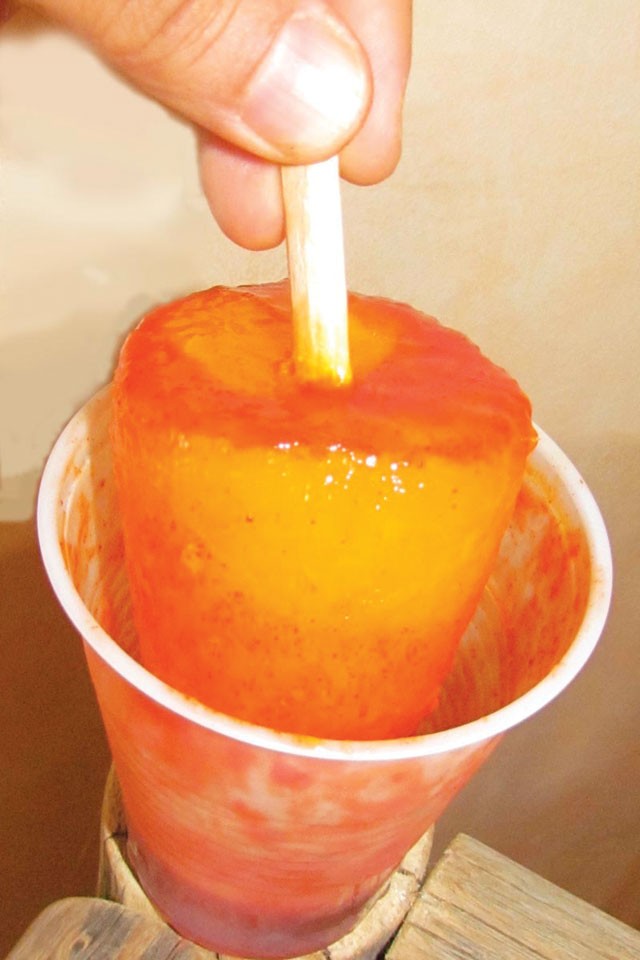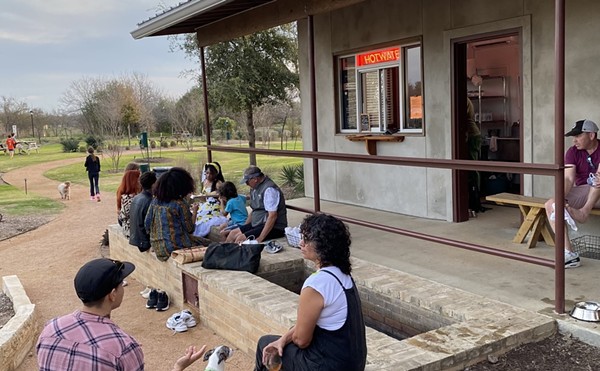A mangoneada is many things: a popsicle, a combination of unlikely flavors, a double-entendre, and an inside joke I can’t seem to crack.
There are many variations on this heat-beating treat, all of which contain mango, chile powder, salt, lime or lemon, and usually chamoy, a Mexican sauce traditionally made from pickled fruit and chile peppers.
A mangoneada is at once too sweet, too spicy, too bitter, too sour, and too salty. But these intense and conflicting flavors somehow manage to play together brilliantly, each highlighting and balancing the other. The same four flavors are often combined in Southeast Asian cuisine with fantastic results. In a mangoneada they have the effect of simultaneously creating and quenching thirst. Because it’s served frozen and contains lots of water, the quenching side wins, especially during the heat of summer.
The mangoneada is an evolution of an old dish commonly called chile mangoes, which consists of mango chunks doused with chile powder (and often salt and lime juice). Sometimes this combination is hit with a shot of chamoy and called a mangoneada, even though it isn’t in popsicle form. Many other variations on the mangoneada equation can be found as well, such as mango ice cream or sherbet with chamoy, or a snow cone in which the mangoneada ingredients are mixed together and poured over ice. But none of these are as striking to the eye and tongue, or as unique in the method of eating, as the dipped popsicle form.
Chamoy is an adaptation of Japanese umeboshi, or pickled plums. The plums (or apricots or tamarind, in the case of chamoy) are soaked in salt-water brine, which draws out much of the fruit’s moisture and flavor. It is this brine, and not the fruit that it pickled, that is the base of chamoy.
What’s sold in stores is rarely derived from the pickled plums or apricots the sauce was traditionally made with. Trechas brand, for example, is made from water, iodized salt, red peppers, citric acid, corn starch, sugar, xanthan gum, sodium benzoate, and Red No. 40.
Cocina Mestiza brand makes a chamoy with natural, traditional ingredients, but is difficult to find. Celebrity chef Rick Bayless has a gringo-friendly chamoy recipe made of apricot jam, sugar, salt, lime juice, and chile. You may notice that these ingredients, with the exception of apricot, are already present in a mangoneada, making this chamoy somewhat redundant. The real chamoy, of course, would add that weird pickled taste, which for some takes time to acquire.
The simplest and easiest way to enjoy the mangoneada equation is chile mangoes style. Simply cut a mango into chunks, squeeze a lime over them, and sprinkle sparsely with coarse salt and thickly with chile powder.
If you want to go popsicle-style, the following chamoy-free recipe can be made with ingredients found in any store. And if you can find the real stuff made the traditional way, then by all means use it. But the artificially flavored chamoy and recipes like Bayless’ don’t add anything you want or need.
Add a pound of cut mangoes, three tablespoons sugar, and a cup of water to a blender. More water will dilute the mango flavor but make the mangoneada more hydrating. Blend and pour the mixture into cups — 8 oz. disposable cups are typically used, but any cup will work as long as the popsicle can slip out. Leave the cups in the freezer until freezing begins. Place a popsicle stick in the middle of each cup, and freeze until fully frozen.
When you’re ready to get your mangoneada on, dip the cup in warm water so the popsicle inside loosens. Remove the popsicle and squeeze a lime’s worth of juice into each cup, a teaspoon or tablespoon of chile powder (depending on its strength and your heat tolerance), and salt to taste. Mix it up and replace the popsicle in the cup. Start eating your mangoneada. Dip into the sauce and repeat. •
Ari LeVaux writes Flash in the Pan, a nationally syndicated weekly food column. His writing has appeared in more than 50 newspapers and magazines, and on various websites including Alternet and The Atlantic. He lives in Montana and New Mexico.


















